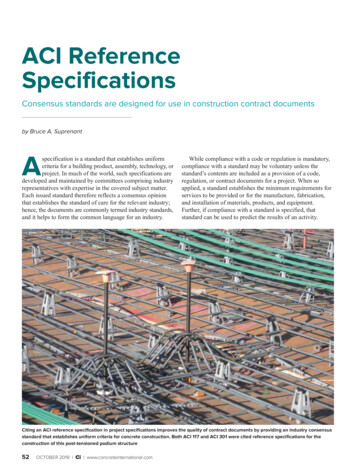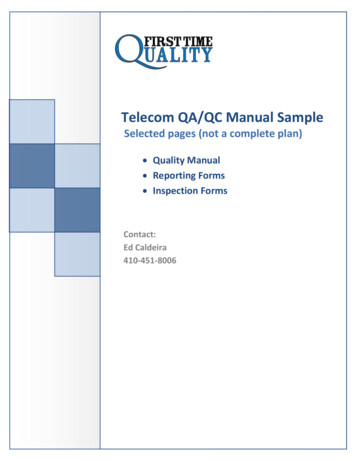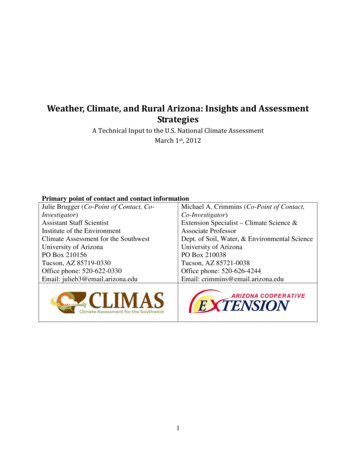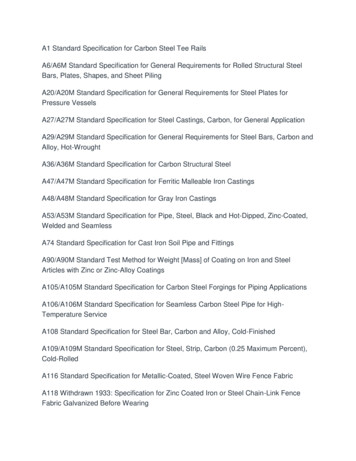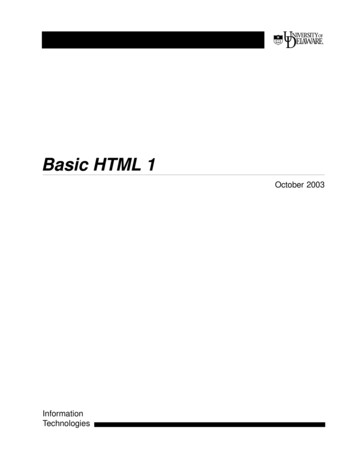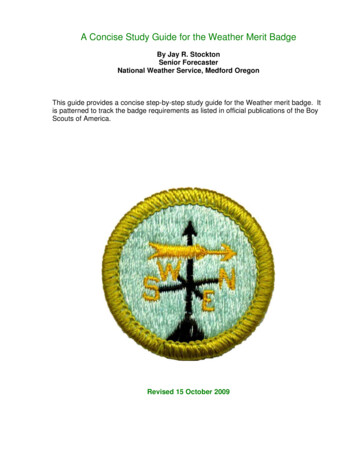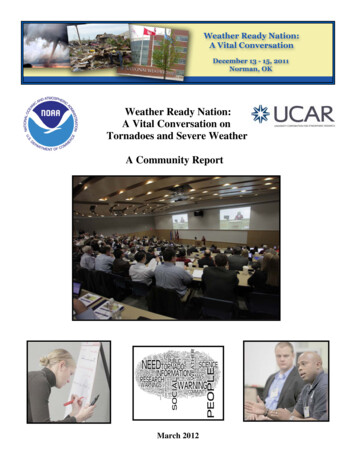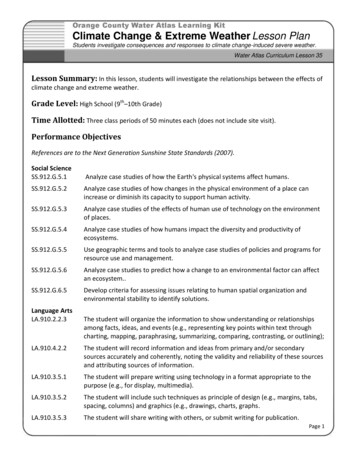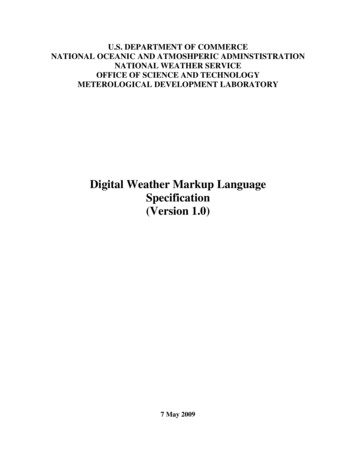
Transcription
U.S. DEPARTMENT OF COMMERCENATIONAL OCEANIC AND ATMOSHPERIC ADMINSTISTRATIONNATIONAL WEATHER SERVICEOFFICE OF SCIENCE AND TECHNOLOGYMETEROLOGICAL DEVELOPMENT LABORATORYDigital Weather Markup LanguageSpecification(Version 1.0)7 May 2009
Table of ContentsList of Figures. iList of Tables . ii1. Overview: . 11.1.DWML Requirements . 11.2.DWML Structure. 11.3.Sample Document . 12. DWML Data Element Nomenclature: . 13. Framework Elements: . 23.1. dwml Element . 23.1.1.version Attribute. 23.2. head Element. 23.3. data Element . 24. DWML Metadata Elements . 24.1. product Element . 24.1.1.concise-name Attribute. 34.1.2.srsName Attribute . 34.1.3.operational-mode Attribute. 34.1.4. title Element . 34.1.5. field Element . 34.1.6. category Element . 44.1.7. creation-date Element . 44.2. source Element. 44.2.1. more-information Element . 44.2.2. production-center Element. 44.2.3. disclaimer Element . 44.2.4. credit Element. 54.2.5. credit-logo Element . 54.2.6. feedback Element . 55. DWML Data Elements . 55.1. location Element . 55.1.1. location-key Element. 55.1.2. point Element. 55.1.3. city Element. 55.1.4. nws-zone Element . 65.1.5. area Element . 65.1.6. point Element. 65.1.7. point Element. 75.1.8. point Element. 75.1.9. point Element. 75.1.10. point Element. 75.1.11. height Element . 75.1.12. level Element . 75.1.13. layer Element . 85.2. moreWeatherInformation Element . 85.2.1.applicable-location Attribute . 8File: MDL XML Design.docLast Updated: August 12, 2003Page:ii
5.3. time-layout Element . 85.3.1.time-coordinate Attribute. 85.3.2. layout-key Element. 85.3.3. start-valid-time Element . 95.3.4. end-valid-time Element. 95.4. parameters Element . 95.4.1.applicable-location Attribute . 95.4.2. temperature Element . 95.4.3. precipitation Element. 115.4.4. probability-of-precipitation Element. 125.4.5. convective-hazard Element. 135.4.6. wind-speed Element . 145.4.8. cloud-amount Element . 185.4.9. weather Element . 195.4.10. humidity Element . 205.4.11. conditions-icons Element . 215.4.12. wordedForecast Element . 225.4.13. water-state Element. 225.5. categorical-definitions Element. 265.5.1. categorical-table Element . 275.6. conversion-definitions Element . 275.6.1. conversion-table Element. 276. Latitude and Longitude Lists. 286.1. latLonList Element . 287. Common Element and Attribute Definitions . 287.1.1.latitude Attribute . 287.1.2.longitude Attribute . 287.2.vertical-coordinate Attribute . 287.3.summarization Attribute. 287.4.time-layout Attribute. 288. XML Considerations . 288.1.Namespace . 288.2.Schema . 288.3.Character Set. 29Appendix A: DWML Requirements . 301. Overview . 302. XML Components. 303. DWML Validation . 334. General Characteristics. 335. Product Samples. 33Appendix B: Requirements Correlation Matrix. 37Appendix C: Data Model . 39Appendix D: Product Samples. 46Forecast at a Glance. 46NWS Web Site Product . 46Analogous DWML . 46File: MDL XML Design.docLast Updated: August 12, 2003Page:iii
Digital Tabular Forecast . 49Sample Digital Tabular Forecast Product. 49Analogous DWML . 49Digital Zone Forecast. 54Sample Digital Zone Forecast Product . 54Analogous DWML . 54Model Output Statistics Bulletin . 58Sample Model Output Statistics Product . 58Analogous DWML . 58Appendix E: Type Definitions. 70Appendix F: References . 93File: MDL XML Design.docLast Updated: August 12, 2003Page:iv
List of FiguresFigure 1.Figure 2.Figure 3.Figure 4.Figure 5.Figure 6.Figure 7:Example Forecast at a Glance Product. 34Example Digital/Tabular Forecast Product . 34Example Digital Zone Forecast Product. 34Forecast at a Glance. 46Digital/Tabular Forecast. 49Digital Zone Forecast . 54Sample Model Output Statistics Bulletin. . 58
List of TablesTable 1. DWML Content by Product. 36Table 2: Sky Cover to Text Conversion (Source: NWSI 10-503). . 82Table 3: Valid Values for Weather Coverage Attribute. . 83Table 4: Valid Values for Weather Intensity. . 83Table 5: Valid Weather Values. 83Table 6: Valid Weather Attributes. 84Table 7: Valid Visibility Values. . 84Table 8: NDFDgen Night Time Icon Algorithm (priority in ascending order). . 85Table 9: NDFDgen Day Time Icon Algorithm (priority in ascending order). 87Table 10: NDFDgenByDay Night Time Icon Algorithm (format ’12 hourly’) (priority inascending order). 88Table 11: NDFDgenByDay Day Time Icon Algorithm (format ’12 hourly’ or ’24 hourly)(priority in ascending order). . 90Table 12: NDFDgenByDay Weather Summary Phrases (format ’12 hourly’ or ’24 hourly’)(priority in ascending order). . 92Table 13: NDFDgenByDay Weather Summary Phrases (format ’12 hourly’) (priority inascending order). 92File: MDL XML Design.docLast Updated: August 12, 2003Page:ii
1. Overview:This document defines the Digital Weather Markup Language (DWML). DWML is a new XMLlanguage which is being developed to initially support the exchange of the National WeatherService’s (NWS) National Digital Forecast Database (NDFD) data. However, the specificationis being written with enough flexibility to accommodate other environmental scienceapplications. Appendix E provides a definition of DWML types based on restrictionsappropriate to NDFD data. Other sets of restrictions similar to those in Appendix E need to beestablished for other specific implementations.1.1. DWML RequirementsThis specification attempts to include requirements in the MDL NDFD XML Requirementsdocument (Appendix A). The matrix in Appendix B indicates which design feature satisfieswhich requirement.1.2. DWML StructureThe tree diagrams in Appendix C provide a graphical representation of how DWML elementsand attributes relate to each other. These relationships in concert with the DWML typedefinitions in Appendix E form the basis for language validation.1.3. Sample DocumentIn addition to providing a definition of the elements and their attributes, this specificationprovides sample DWML documents in Appendix D for the three products proposed in the NDFDXML Requirements document. Appendix D also includes the application of DWML elements toa Model Output Statistics (MOS) bulletin. The MOS bulletin example is a non-NDFD exampleand so it does not conform to the NDFD type definitions. The MOS bulletin example is providedmerely to illustrate the flexibility of DWLM to handle other data sources.2. DWML Data Element Nomenclature:This specification uses the following approach to describing elements:1)Element and attribute names are all lower case.2)Element and attribute names use a hyphen (“-“) to separate multiple word names so as toimprove readability (ex. creation-date ). Attribute and element names avoid the use ofabbreviations to enhance readability.3)Within this document, child elements are nested in a sub-paragraph under their parents.4)Attributes are also nested but do not have the angle brackets (“ ”) and are italicized.5)The element’s and attribute’s type is provided in braces (“{}”). For more information oneach type refer to Appendix E.File: MDL XML Design.docLast Updated: August 12, 2003Page:1
6)If the element can occur zero or more times, an asterisk (“*”) is placed after its name. Seespecification 5.2.1.5 for an example.7)If the element occurs zero or one times, a question mark (“?”) follows its name. Seespecification 4.1.3 for an example.8)If the element must appear at least once, a plus sign (“ ”) trails its name. See specification5.2.1 for an example.9)Element names without a special trailing character must occur exactly once. Specification3.1 provides an example of an element that is required exactly once.10) Each DWML specification references the requirement that it is designed to meet. Therequirement is positioned at the end of the specification and contained in parentheses. Forexample, specification 3.1 satisfies requirement 4.2.11) The order of element descriptions in the paragraphs below is not significant. Any requiredordering of elements is specified in the tree diagrams found in Appendix C and typedefinitions in Appendix E.3. Framework Elements:3.1. dwml ElementThe dwml element {dw:dwmlType}: The root element for DWML (R4.2).3.1.1. version AttributeThe version attribute {xsd:string} indicates which version of DWML the instance contains(R2.1.3).3.2. head ElementThe head element {dw:headType} contains the metadata for the DWML instance. See section4 for elements found in the head element (R4.2).3.3. data ElementThe data element {dw:dataType} contains the environmental data. See section 5 for childelements of the data element (R4.2 and R2.2).4. DWML Metadata ElementsDWML metadata provides information about the DWML product and the data it contains. Theseelements are children of the head element.4.1. product ElementThe product element {dw:productType} holds meta information about the product.File: MDL XML Design.docLast Updated: August 12, 2003Page:2
4.1.1. concise-name AttributeThe concise-name attribute {dw:concise-nameType} represents a name or code that describesthis product. The concise-nameType will have a list of names that is extensible to supportsecondary developer additions. Sample values include “glance”, “digital-tabular”, “digital-zone”(Derived From R2.1.1).4.1.2. srsName AttributeThe srsName attribute {dw:srsNameType} communicates the spatial reference system used byNDFD. The NDFD spatial reference system is the “WGS 1984”.4.1.3. operational-mode AttributeThe operational-mode attribute {dw:operational-modeType} defines the status of the product.Applications can review the content of this element to determine if they should perform furtherprocessing. Sample values include “test”, “developmental”, “experimental”, and “official”product. (R2.1.4)4.1.3.1. Test ProductThe “test” product indicates that this is an instance of an existing DWML product that containssome change being evaluated by a DWML development team. Users will typically not processthis product (R2.1.4.1).4.1.3.2. Developmental ProductThe “developmental” product represents a new product that is not yet ready for public evaluationor use (R2.1.4.2).4.1.3.3. Experimental ProductThis product is available for testing and evaluation for a specified, limited time period for theexplicit purpose of obtaining customer feedback. (R2.1.4.3).4.1.3.4. Official ProductThe “official” product identifies an instance of an established DWML product. This DWMLinstance is part of the approved product suite available from the NWS (R2.1.4.4).4.1.4. title ElementThe title element {xsd:string} [?] provides a concise summarization of what this DWMLproduct contains (R2.1.1).4.1.5. field ElementFile: MDL XML Design.docLast Updated: August 12, 2003Page:3
The field Element {dw:fieldType} specifies the general area within the environmentalsciences that the data contained in the DWML instance is from. Example values include“meteorological”, “hydrological”, “oceanographical”, “land surface”, and “space” (R2.1.5).4.1.6. category ElementThe category Element {dw:categoryType} [?] defines the specific category that the productbelongs to. Example values include “observation”, “forecast”, “analysis”, and “statistic”(R2.1.6).4.1.7. creation-date ElementThe creation-date Element {xsd:creation-dateType} contains the date and time that theproduct was prepared (R2.1.2).4.1.7.1. refresh-frequency AttributeThe refresh-frequency attribute {xsd:duration} is used by the production center to help usersknow how often to return for updated data. In the case of the NDFD, the data is updated on an asneeded basis. As a result the frequency provided may not always ensure users update as soon asnew data is available. The frequency will also not guarantee that that when updates are done thatthe retrieved data is new. Still, the suggested refresh frequency will help well mannered usersknow what the provider believes is a reasonable time between repeated accesses of the system(R2.1.14).4.2. source ElementThe source Element {dw:sourceType} [?] holds information about the product’s source andlinks to credit and disclaimer information.4.2.1. more-information ElementThe more-information element {xsd:anyURI} is a link to the web page of the forecast’ssource or a more complete forecast (R2.1.13).4.2.2. production-center ElementThe production-center element {xsd:production-centerType} [?] identifies which organizationcreates the product (R2.1.7).4.2.2.1. sub-center ElementThe sub-center element {xsd:string} [?] is the part of the production center that prepared theproduct (R2.1.8).4.2.3. disclaimer ElementThe disclaimer element {xsd:anyURI} [?] is the URL containing a disclaimer regarding thedata (R2.1.9).File: MDL XML Design.docLast Updated: August 12, 2003Page:4
4.2.4. credit ElementThe credit Element {xsd:anyURI} [?] is the URL used to credit the source of the data(R2.1.10).4.2.5. credit-logo ElementThe credit-logo element {xsd:anyURI} [?] is the image link used with the credit URL toacknowledge the data source (R.2.11).4.2.6. feedback ElementThe feedback Element {xsd:anyURI} [?] is a URL to a web page used to provide theproduction center comments on the product (R2.1.12).5. DWML Data ElementsThese elements hold the environmental data. They are children of the data element.(R2.2).5.1. location ElementThe location element {dw:locationType} [ ]: Defines the location for the data contained inthe element data . The element must contain exactly one of its child elements (R2.2.2).5.1.1. location-key ElementThe location-key element {dw:location-keyType} [?] is used to relate the location to itscorresponding parameters (R2.2.2).5.1.2. point ElementFor information on the point element see Section 7.15.1.2.1. summarization AttributeFor information on the summarization attribute see Section 7.3.5.1.3. city ElementThe city element {dw:cityType} [?] contains the city name for which the data is valid(R2.2.2).5.1.3.1. state AttributeThe state attribute {dw:stateType} holds the two digit abbreviation for the state that the cityresides in (R2.2.2).5.1.3.2. summarization AttributeFile: MDL XML Design.docLast Updated: August 12, 2003Page:5
For information on the summarization attribute see Section 7.3.5.1.4. nws-zone ElementThe nws-zone element {dw:nws-zoneType} [?] contains the National Weather Serviceforecast zone name for which the data is valid (R2.2.2).5.1.4.1. state AttributeThe state attribute {dw:stateType} holds the two digit abbreviation for the state that the cityresides in (R2.2.2).5.1.4.2. summarization AttributeFor information on the summarization attribute see Section 7.3.5.1.5. area ElementThe area element {dw:areaType} [?] is a geometrical shape may be used to define which gridpoints the data represents. The element must contain exactly one of its child elements (Derivedfrom R2.2.1.5).5.1.5.1. area-type AttributeThe area-type attribute {dw:area-typeType} defines the aerial shape being used. Permissiblevalues include “circle” and “rectangle” (Derived from R2.2.1.5).5.1.5.2. circle ElementThe circle element {dw:circleType} [?] is a circular area about a grid point. The area cancontain any number of grid points which are summarized.5.1.6. point ElementFor information on the point element see Section 7.15.1.6.1.1. radius ElementThe radius element {dw:radiusType} is the distance from the center point of the circle to edgeof the circular area (Derived from R2.2.1.5).5.1.6.1.1.1.radius-units AttributeThe radius-units attribute {dw:radius-unitsType) is the units of the radius measurement.Example values include “statute miles” and “kilometers” (Derived from R2.2.1.5).5.1.6.2. summarization AttributeFor information on the summarization attribute see Section 7.3.File: MDL XML Design.docLast Updated: August 12, 2003Page:6
5.1.6.3. rectangle ElementThe rectangle element {dw:rectangleType} [?] is a rectangular area which is defined by fourlatitude and longitude pairs. The area can contain any number of grid points which aresummarized.5.1.7. point ElementFor information on the point element see Section 7.15.1.8. point ElementFor information on the point element see Section 7.15.1.9. point ElementFor information on the point element see Section 7.15.1.10. point ElementFor information on the point element see Section 7.15.1.10.1. summarization AttributeFor information on the summarization attribute see Section 7.3.5.1.11. height ElementThe height element {dw:heightType} [?] is the data point’s distance above/below somedatum. If this element is not present, it is assumed that the data values are surface based(R2.2.2.3.1).5.1.11.1. datum AttributeThe datum attribute {dw:datumType} is the reference for the height measurement. Examplevalues include “surface” and “mean sea level” (R2.2.2.3.1.1).5.1.11.2. height-units AttributeThe height-units attribute {dw:unitsType}represents the units of measure used for the heightvalue. Example values include “feet” and “meters” (R2.2.2.3.1.2).5.1.12. level ElementThe level element {dw:levelType} [?] allows the data to be valid at some specific level. Forexample, within model data, a value may apply to a sigma level (R2.2.2.3.2).5.1.12.1. vertical-coordinate AttributeFile: MDL XML Design.docLast Updated: August 12, 2003Page:7
For information on the vertical-coordinate attribute see Section 7.2.5.1.13. layer ElementThe layer element {dw:layerType} [?] allows the data to be valid for some specific layer. Forexample, within model data, a value may be valid through a sigma layer (R2.2.2.3.3).5.1.13.1. vertical-coordinate AttributeFor information on the vertical-coordinate attribute see Section 7.2.5.2. moreWeatherInformation ElementThe moreWeatherInformation element {xsd:anyURI} contains a link to the NDFD point-andclick forecast page for each set of user requested lat/lon pairs.5.2.1. applicable-location AttributeThe applicable-location attribute {dw:applicable-locationType} [?] is used to relate the locationto a particular list of parameters (R2.2.1). In this case it is the user requested point number.5.3. time-layout ElementThe time-layout element {dw:time-layoutType } [ ] contains the start and stop valid timesand any associated period names for the data. Since different environmental parameters havedifferent time schemes (valid at different interval and available for different lengths of time intothe future), there will be one time-layout element for each of these unique temporalconfigurations. Each data parameter will reference exactly one of these time layouts (R2.2.3).5.3.1. time-coordinate AttributeThe time-coordinate attribute {dw:time-coordinateType} defines the time coordinate as either“
6) If the element can occur zero or more times, an asterisk ("*") is placed after its name. See specification 5.2.1.5 for an example. 7) If the element occurs zero or one times, a question mark ("?") follows its name.
